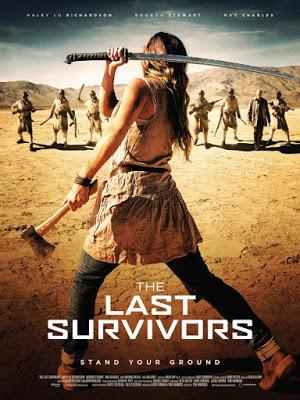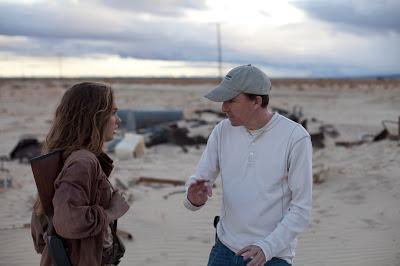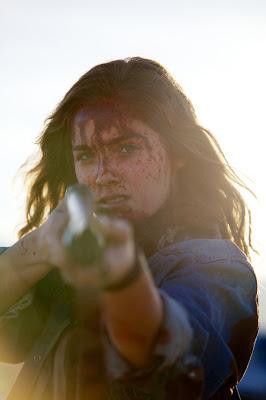
Thomas S. Hammock Digs Deep With The Last Survivors
With the growth of technology over the past decade, it’s become possible for literally anybody to record a song, write a book or make a movie. With the inundation of content into the marketplace, it’s become more difficult than ever before for real filmmakers to get their work made, seen and, perhaps most significantly, monetized. Hollywood wants $300 million-budgeted tentpole comic book movies that will play as well in Beijing and New Delhi as they do in Muncie and Canoga Park. The indie film movement, once occupied by names like Quentin Tarantino, P.T. Anderson and Steven Soderbergh during its 1990s heyday, is basically non-existent now, those filmmakers having moved on to big-budget (or at least bigger than their salad days), more epic filmmaking. Many aspiring directors and producers find this landscape to be a bleak one, akin to the post-apocalyptic world first introduced by George Miller’s Mad Max films, also products of an indie film movement.
Filmmaker Thomas S. Hammock took a cue from both.
A veteran production designer of over 15 feature films, including All the Boys Love Mandy Lane, The Guest, You’re Next, V/H/S/2, and Robert Kirkman's upcoming Outcast, Hammock was determined to see his vision brought to the screen by any means necessary, even if it meant shooting a feature for $200K in the middle of a freezing winter desert with a skeleton crew over a few weeks.
The result, The Last Survivors (aka The Well), has become a sensation in the independent film world, garnering accolades at dozens of film festivals and earning praise from such prestigious press outlets as Indiewire, The Hollywood Reporter and the LA Weekly. A post-apocalyptic tale about a teenage girl fighting to protect the last working well in a drought-stricken valley, the film boasts fine performances from a cast of newcomers, including star Haley Lu Richardson, Booboo Stewart and Nicole Fox, as well as veteran thesps Jon Gries, Rena Owen and Barbara Crampton. Hammock, who has degrees in Architecture from UC Berkeley and Production Design from The American Film Institute, co-wrote the script with AFI classmate Jacob Forman. Other AFI alum include producer Seth Caplan and editor Sarah Broshar. It is being distributed by Dark Sky Films.
Tom Hammock sat down with us recently to discuss his freshman directing effort. Here’s what was said:

Let’s start at the beginning: how was this idea born?
Thomas S. Hammock: Jacob Forman and I were driving back from Texas after All the Boys Love Mandy Lane wrapped and we drove through an area in eastern New Mexico where all the wells had dried out and the ground water had evaporated. They were having to truck water into all these small towns. Right away, we got this idea for a post-apocalyptic western. We sat on it a while, then I was doing a film in Korea with Adam Wingard and we lost our financing and the whole thing fell apart. The people who financed it, Federighi Films, were friends of mine, had the contingency left over, about $200,000, and said “If you can do a SAG ultra-low budget movie by the end of the fiscal year with this money, we’ll do it.” So we sent them the treatment, they said yes, Jacob and I spent three weeks writing the first draft, then we spent four weeks casting, then we were shooting. It was that fast.
You had to build your movie around the budget, as opposed to the other way around.
Exactly. It was brutal, but we didn’t have time to think about how brutal it was. I had little to no pre-production with most of my cast and crew and nothing with the cinematographer. We shot this dry, no shot list. (Cinematographer) Seamus (Tierney) was shooting a film in India. He flew in. I drove him to the set. We started shooting the next day. Never again. (laughs)
How long was the shoot?
Eighteen days in the desert, four days on stage, but we could only shoot eight hour days.
How many set-ups per day?
We averaged forty-five set ups per day.
One, two takes tops. Then move on.
Two takes, tops. It was tough, but since most of our leads were kids, they had the stamina to do it.
 Star Haley Lu Richardson confers with director Thomas S. Hammock.
Star Haley Lu Richardson confers with director Thomas S. Hammock. Haley, your lead actress, was impressive.
She is and this is her first major credit. She had been in a local commercial in Phoenix and moved to L.A. to become a professional, with her mom. We scored finding her.
You had neophytes but also a lot of veteran actors, to balance things out.
Yeah, and the vets helped a lot. Rena Owen from Once Were Warriors, Michael Masse from Se7en and The Crow. They were all amazing and instantly signed on after reading the script. We had an amazing, experienced crew, as well, who really helped make things happen. It just all came together somehow.
Had you always wanted to direct?
No, it’s something that came after a time. I’m a production designer, was always curious about directing, but never had the desire until recently.
Was it born out of curiosity, frustration, or a mix of both?
Really just curiosity. Being a production designer, you have a lot of freedom to do your own thing.
So you’re still a full-time production designer.
Yes, although I would love to direct more.

What was your biggest pleasant surprise and your biggest horrific surprise during the shoot?
Oh boy. Biggest pleasant surprise was that we were able to pull off action scenes with this budget level. We only had one take with each squib going off, which wasn’t just due to the cost of the squib, but the cost of the clothing. We gave up shots on this movie over $40. The biggest horrific surprise would have been the weather. We shot in the desert during the winter, so even though it was supposed to be scorching hot, it was actually about thirty degrees out. When Haley is swimming through the oil, there was a layer of ice on top of it.
I’m assuming she wore a wet suit.
Yeah, she had a skin wet suit on. But even so…
And that wasn’t really oil, I’m guessing.
No, it was milk-based fingerpaint, like little kids use in pre-school. Five hundred gallons of that, our single biggest expense on the movie.
The film is a very clever homage to one of our mutual favorite movies, the original Mad Max, and not just in terms of the film’s look.
Right. Distributor caps from certain cars can be used in certain airplane engines. Mad Max is introduced changing the distributor cap in his car, in the original film. We got the same kind of distributor cap from Australia that Max was putting into his car. That’s the cap that Haley puts into her airplane. So it’s a great Easter Egg for the film, for people who like that sort of thing.
Let’s talk about the Mad Max-influenced look of the film.
I used to live in Australia, worked for the government in the Outback. Everything is so stark out there, there’s nothing quite like it. It’s also a lot about the lenses we used: medium and wide lenses. You want to show the vistas. It’s not just super-tight framing. We also tried to do it with the staging of the action and the way we cut it.
What advice would you have for someone who’s thinking about directing their first micro-budget film?
If we want to stand out, you need to build a world and as you’re building a world, allow your collaborators to do something different from what they’ve done before. That’s how you’ll attract great people.
